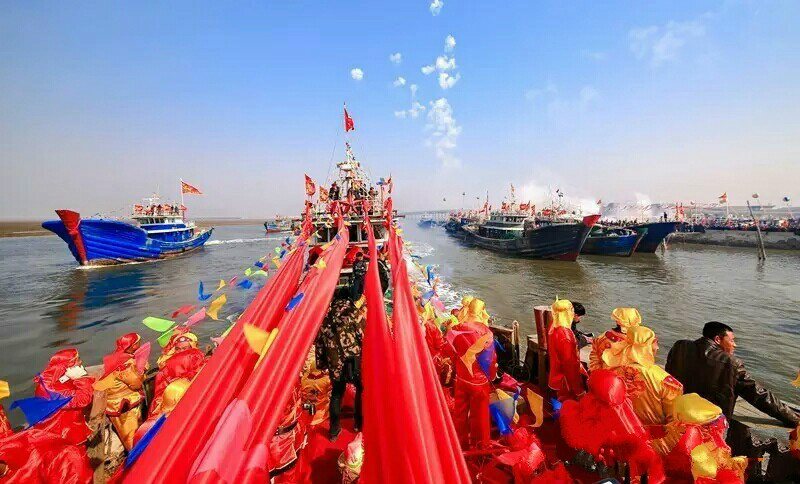Fishing festival showcases legendary migratory fishermen of Liaodong Bay

Approximately 30,000 citizens and visitors gathered at the second Erjiegou Fishing Festival ceremony at Liaodong Bay, Liaoning Province.
In late March, the second Erjiegou Fishing Festival ceremony kicked off at Liaodong Bay, Panjin City, Liaoning Province. Hundreds of fishing boats sailed toward the deep blue ocean. Approximately 30,000 citizens and visitors gathered at this ceremony to witness this spectacular reproduction of the fishing activities of ancient migratory fishermen.
“Ancient migratory fishermen,” or guyuyan in Chinese, literally means ancient fishing geese, which is metaphorically used to refer to fishermen who migrated like birds chasing the route of fish and shrimp hundreds of years ago. In the spring, these fishermen from Henan, Hebei, Jiangsu and Shandong provinces walked the overland route or sailed a boat through waterways to catch fish at Liaodong Bay. The geographic location of Liaodong Bay is quite particular, because it is the fishery with the highest latitude in China and every winter the sea water freezes and the frozen period of the ocean lasts a long time. In the past, when winter came, groups of fishermen left this area like migratory birds. So later generations called these regular migratory fishermen “fishing geese” or yuyan in Chinese.
At present, this migratory fishing style is mostly extinct around the world, but remains in the estuary of the Liaohe River. Fishermen in Erjiegou Town near the estuary of the Liaohe River, Liaoning Province, still maintain migratory customs. These modern “fishing geese” work on the waves of the Bohai Sea, which is China’s continental sea, and the Yellow and East China seas, which are marginal seas of the Pacific Ocean, passing through the harbors and estuaries of Shandong Province. They are the living fossils of an ancient custom in the modern era.
Over centuries of catching fish and shrimp, ancient migratory fishermen left behind legends and stories, which recorded their legendary experience on different seas and beaches. These stories were orally passed down from generation to generation. In 2006, folk stories of ancient migratory fishermen were selected in the list of national intangible cultural heritage. These folk stories, mainly spread in Erjiegou Town, reflect fishermen’s lives, customs, traditions, beliefs and cultural creations in all respects and are characterized by their short length and simple plots about fishermen’s worship of ancestors, sea lords and dragon kings along with tales of their sacrificial ceremonies and celebrations, and the origin and evolution of fishing gear.
Ancient migratory fishermen lived by and on the sea and established a harmonious relationship with it. Though time has passed, ceremonies for the fishing period have gradually become a regular occurrence. Nowadays, the local government and visitors have favorable attitudes toward Fishing Festival ceremonies, which are good for the inheritance of the culture of ancient migratory fishermen, attracting more and more young people to participate in this cultural activity.
This year, the Erjiegou Fishing Festival presented a magnificent sacrificial ceremony, and it revealed fishermen’s unique local folk culture. The festival also boosted the local economy. Those surrounding restaurants that served fish cuisines, and delicious fish snacks, fresh catch and marine food products sold in the booths near the festival ceremony, attracted a number of customers.
A local official indicated that the Fishing Festival helps young people directly experience maritime cultures and traditions, so they can better understand the ocean, value marine resources and respect traditional maritime cultures. The festival ceremony not only promotes the development of local cultural tourism but also realizes the productive protection of the intangible culture of migratory fishermen. Old wharfs and shipyards will be renewed and museums of fishermen’s culture will be established under the local construction plan.
